VOL.48, NO. 4
Unpicking the Literary Threads in Humphrey Jennings’ Film Making Fashion
Sarah Watson (University of Sussex, U.K.)
1. Persephone and Jennings
In 1930 the painter Thomas Lowinsky produced fourteen fashion plates called Modern Nymphs depicting Greek goddesses in contemporary settings. One plate, ‘The Return of Proserpine to a Favourite Grove’, presents the goddess in a utilitarian outfit with her shirt modestly buttoned to the top. A steel girder frames her as she looks contemptuously at the grove, which consists of smoking factories and train lines. Lowinsky's industrial city starkly contrasts classical notions of Proserpine’s grove, for instance as described by Ovid:
The boughs do yield a cool fresh air; the moistness of the ground
Yields sundry flowers; continual spring is all the year there found (165).
Lowinsky reconsiders Proserpine (also known as Persephone) for the twentieth century. The introduction to Modern Nymphs states that ‘these legends take on new meaning every year … There is no end to the psychological truth implicit in Greek legend’ (Mortimer 16). This paper examines Humphrey Jennings’ original, and arguably controversial, presentation of Persephone in his film Making Fashion (1938), which documents the work of the dress designer Norman Hartnell.1 The paper focuses on the way Making Fashion adapts literary depictions of Persephone to help Jennings generate a subtle commentary on the social situation of Hartnell’s seamstresses, who are debased by their industrious production of evening gowns for the upper classes. Persephone was a popular figure in early twentieth-century culture, making it unsurprising that Jennings chose her to be central to his film. James Frazer’s seminal text, The Golden Bough (1890), helped implant the goddess’ myth in the minds of artists and writers working in Britain at the time. Frazer presents the youthful Persephone … gathering [flowers] in a lush meadow, when the earth gaped and Pluto, lord of the Dead … carried her off … to be his bride … in the gloomy subterranean world’ (456). With help from her father Zeus, Persephone finally leaves the underworld and her escape marks the beginning of spring. However, in Hades Persephone eats six pomegranate seeds and, because she tastes something of the underworld, has to reside there for half the year. I argue that Making Fashion embraces the dual character of death and new life in the Persephone myth. On the surface Jennings’ film appears wholly fresh-faced, as youthful women parade in glamorous evening gowns. However, through reference to some of Persephone’s literary associations, I suggest that in Making Fashion Ovid’s boughs and flowers become Lowinsky’s girders and smoking factories. This paper argues that beyond the light-heartedness of beautiful girls wearing glamorous dresses there lies a much weightier subject: the exploitation of worker as ‘mere machine’ (Engels 12).
On the surface Making Fashion appears incongruous with most of Jennings’ other films, which generally depict the working and middle classes as opposed to young ladies from high society modelling expensive clothing. Making Fashion is a promotional film for Hartnell, who acted as co-producer alongside Adrian Klein, and can be read as a mere advertisement of his work. On the one hand, the collaboration between Jennings and Hartnell is unsurprising considering the two studied together at Cambridge. However, Making Fashion’s subject matter is notably unusual for Jennings, as recognised by Simon Brown who supposes that the content of the film sat outside of Jennings’ control, emerging from a deal made exclusively between Hartnell and Klein. It is easy to assume that Jennings made the film for money rather than with artistic intent, particularly as finance was a problem for Jennings and his young family in the late 1930s2 and the film’s commercial aspect might be a reason for its general neglect by Jennings scholars.3 This paper provides a close reading of Making Fashion to argue that beyond its light-hearted exterior, there is a serious social commitment to the nameless labour underpinning the fashion world. Jennings unpicks haute couture with the intellectual reserve he had developed during the late 1920s and 1930s, drawing upon his literary education at Cambridge and weaving it together with the socialist outlook cultivated during his involvement with Mass Observation. One cannot ignore the fact that the year Jennings filmed Making Fashion, he also lived in an unemployed spinners’ house in Bolton as part of his Mass Observation research. Bolton introduced Jennings to ‘an England he had not known before – the land of industry, of the factory’, and it was here that he read Fredrich Engels and began to deepen his feeling for the working class (Pitman 12). In Making Fashion Jennings uses literature, particularly poetry, to comment upon the conditions of the working class. This is a tool commonly deployed in Jennings’ films and can be seen in Words for Battle (1941), produced by the Ministry of Information, which uses prose and poetry from William Blake, John Milton and Robert Browning to accompany documentary footage of Second World War soldiers and civilians. Laurence Olivier reads Blake’s Jerusalem (1808) over images of child evacuees leaving London by train, which is clearly now the modern embodiment of Blake’s ‘Chariot of Fire’ (“And did those feet” 239). As Anthony Hodgkinson and Rodney Sheratsky state: ‘The accompanying images do not merely illustrate the words. They reverberate with them, providing fresh associations’ (55). Images of evacuees and steam trains cause Jerusalem to take on new meanings as the poem narrates the lives of ordinary, twentieth-century people. The year Making Fashion was released, Jennings delivered a series of BBC radio broadcasts entitled The Poet and the Public (1938), campaigning for poetry to represent everyday life, in particular the social conditions of the proletariat.4 Making Fashion can be seen to be part of this campaign, albeit in a very subtle way as the commercial aspect and elitist subject matter of the film forces literary representations of the working class to remain somewhat veiled behind the glamour of Hartnell’s fashion house. By analysing the social commentary in Making Fashion, I assert that the film is not an inconsequential anomaly in Jennings’ oeuvre, but should be praised as a piece of film-poetry equal to the celebrated accomplishments of his other work, such as A Diary for Timothy (1946).
To begin our analysis, we consider the backdrop against which Making Fashion is set: the advent of the popularisation of colour film. Making Fashion was produced by Dufay-Chromex, a company set up in 1936 to promote the use of Dufaycolor film stock. Colour film was still relatively novel in 1938 and therefore must have been a selling point for Making Fashion. Besides attracting an audience, colour plays an important role in situating the bleak reality of Hartnell’s seamstresses against the opulence of his gowns and models. Jennings utilises Dufaycolor film stock most explicitly in the film’s catwalk sequence, whereby colour helps to give each dress a “name” and a “personality” (00:07:10-00:07:14). The catwalk sequence presents the viewer with outfits entitled: “rambling rose … pink paradise … lilac time … cherry ripe” (00:07:31-00:09:12). The distinct colours of the clothing create an individualism for the models that is clearly absent for the seamstresses who, unremarkably clothed and working uniformly, sit around a table sewing. Noting this contrast and considering Jennings’ choice of reading in 1937, one recalls Engels’ description of needlewomen working in Victorian England:
There they sit bent over their work and sew from four or five in the morning until midnight. Their health is ruined in a few years and they sink into an early grave, without having been able to earn the barest necessities of life. In the streets below the gleaming carriages of the wealthy middle classes rattle past, and close at hand some wretched dandy is gambling away at faro in a single evening as much money as a needlewoman could hope to earn in a year (239-40).
While the condition of Hartnell’s seamstresses is not as grave as the situation of the needlewomen described by Engels, both represent the repetitive labour and social inequality that concerned Jennings in the late 1930s. These concerns are central to his unfinished text Pandaemonium (1985), which began in 1937 as Jennings started to collate a diverse collection of writings, dating from 1660-1886, with the aim of presenting the ‘imaginative history of the Industrial Revolution’ (Jennings ‘Introduction’ xiii). Pandaemonium includes an extract from Blake’s poem ‘The Song of Los’ (1795), recalling the Enclosure Acts in Britain, which privatised commonly held land, radically altering the balance of power within the rural economy and thus marking a pivotal stage in the development of industrial capitalism. The commons enabled farmers to produce their own means of subsistence. With this land taken away, previously independent individuals came to depend entirely on the market to provide their needs. To purchase commodities on the market these individuals needed to earn money and they could only do this by entering the market as the sellers of a commodity, which was their own labour. As common land disappeared, an increasing number of people sold their labour power, creating a larger pool of labourers. With more people looking for work, enclosure’s effect was thus both to raise the power of large landowners and employers, allowing for greater disciplinary force to be exerted upon the workforce, and to create a more mobile workforce as new wage labourers were forced to move around in search of work. Blake describes how wage labourers, having experienced ‘famine from the heath’, leave the countryside to seek ‘fires in the City’ for new industrial jobs (“The Song of the Kings”106). For Jennings ‘The Song of Los’ detailed industrial modernity’s ‘relationship of economics to the human situation and of the human situation to economics’ (Jennings “The Song of the Kings”107). Jennings’ friend and collaborator, Jacob Bronowski, explained that this relationship was fundamentally that of ‘prosperity for masters, famine for men’ (Bronowski 128). As the latter were restrained, dismayed and thinned by their social situation, the former invented the type of ‘allegoric riches’ found in the catwalk scene of Making Fashion (Blake “The Song of the Kings”106). Such allegory exists in the fantasy that Hartnell’s models are Grecian goddess, as communicated by Jennings when he interrupts the catwalk parade with an image of a Greek Tanagra statuette from the British Museum (Barrow 50). The figurine’s hand-on-hip pose and elaborate clothing bears resemblance to the models. Although the statuette is not a goddess, she recalls another British Museum figurine who is presented as Persephone in Making Fashion. Through this association the link between model and deity is reinforced. The models’ link with ancient wealth and power is fitting when we recall that most fashion models from the 1930s were peeresses. Just like Hartnell’s dresses, the clothing on the Tanagra statuette (the veil and voluminous drapery) marks the ‘wearer’s high status’ (Barrow 52). Interestingly, just as with Jennings’ catwalk scene, the bright colours on the Tanagra clothing were another signifier of the wealth and status of the wearer (Barrow 61).
In Making Fashion, the colour and design of dress establishes a social hierarchy and helps to expose how this hierarchy is founded in fantasy. The same is true in Dufaycolor’s footage of the coronation procession of King George VI on May 12th 1937. The film follows the State Coach travelling from Buckingham Palace to Westminster Abbey, presenting the “red, white and blue of the waving flags, the gold of the decorations, the gorgeous uniforms of the household cavalry, you see them all in their pomp and colour” (The Coronation of King George VI And Queen Elizabeth 00:01:30-00:01:36). In comparison to black and white film, colour footage offers a seemingly more accurate documentation of the ceremony while accentuating its majestic, and therefore fantastical, elements. The double aspect of fact and fantasy was important for Jennings, whose documentary work sought to record ‘the unknown rituals, magical modes of thought, taboos, and wish-images which are rooted in the everyday life of the industrial nation’ (Miller 232). Jennings worked on the Mass Observation text May the Twelfth (1937), which recorded public responses to the coronation of King George VI in the form of diary entries, newspaper cuttings and questionnaires. One diary entry notes: ‘A man is walking home with an Australian’s hat; remark: ‘’E’s got an Aussie’s ‘at, anyway’ (“London on May 12” 166). Its footnote states:
[The] hats seem to be what made the Australians so popular with the crowd. This man has got a kind of trophy. ‘In the Warramunga the headdress which is invariably worn for Kingilli ceremonies is roughly knocked off by an Uluru man.’ Australian Totemism, Prof. Roheim … The emu feather in the Australian hat is itself, of course, borrowed from aboriginal totemism (“London on May 12” 166).
Jennings was interested in the spiritual significance of dress and May the Twelfth demonstrates that this significance not only exists in non-Western cultures, like the Warramunga Tribe, but is also prevalent in Britain. An event like a coronation provides the perfect opportunity to observe modern ‘tribes’ and their propensity for achieving mythopoeic thought through dress. May the Twelfth encourages people to study their own and others’ superstitious behaviour. Quoting Ernest Jones’ translation of Freud’s Totem and Taboo (1913), it pleads to its readers: ‘Strive to possess yourself of what you have inherited from your ancestors … all customs, ceremonies, and laws which the original relations to the primal father has left behind’ (Freud 265-6). The ancient ceremony of coronation is a moment of investiture, whereby the rank of the monarch (the primal father) is formally conferred through the act of crowning. The coronation of George VI demonstrates the ‘animatedness of clothes, their ability to “pick up” subjects, to mold and shape them both physically and socially’ and this is highlighted in Jennings’ day surveys (Jones and Stallybrass 60).
Making Fashion exemplifies the animism of clothes in a similar manner to May the Twelfth. Christopher Breward details the magical element of Hartnell’s gowns by explaining that they were ‘produced for wearing in a largely nocturnal London landscape which offered a fantastical impression of modernity, suffused with nostalgia and shimmering in negative against the rational, egalitarian concerns of the daytime’ (107). Breward expands upon this fantasy by quoting Stephen Graham’s 1925 account of London’s nightlife:
If there is a seeming equality by day, there is an evident disparity by night. Though dukes and tramps may walk Piccadilly in the sunlit hours there is no such companionship in the night. Then doss house and mansion are like serf’s hut and baronial castle. Thus the past has a stronger hold on the night than it has on the day … Night sends each to his home, to his own place (107).
Graham’s description of dukes and tramps recalls Engels’ discussion of the disparity between dandies and needlewomen (239-40). This disparity sits at the heart of Making Fashion and, as will be shown, is exemplified by the antithetical environments of the seamstresses and the models. The latter’s social sphere was epitomised by an Olympian Ball held at Claridges in March 1935. The night-time nobility, as described by Graham, went dressed as Greek gods and goddesses in costumes designed, amongst others, by Oliver Messel and Cecil Beaton. Many of the ladies went to the portrait photographer ‘Madame Yevonde’ (Yevonde Cumbers Middleton) to be photographed in their attire, which resulted in a series of photographs of classical goddesses. The photograph of Persephone presents the goddess as the embodiment of both death and new life. She wears a wreath of pastel shaded flowers round her hair, providing the cylindrical headdress by which the goddess is often identified in art. The photograph is backlit so that the light comes through the hair and gives an angelic impression but also, as it highlights only the face, the appearance of a disembodied head. Unlike many of the other goddesses in the series, Yevonde does not offer Persephone an obvious contextual trope. In other photographs a bull accompanies Europa and an owl signifies Minerva. In contrast, Persephone is surrounded by darkness. This void may subtly suggest Hades, while the headdress of flowers seems to hint at a spring garden. Like Yevonde, Jennings does not overtly reference the duality of Persephone. In Making Fashion, the darker side of the goddess’ story, which arguably acts as a metaphor for the seamstresses’ exploitation, is suggested through the film’s commentary, content, camera angles and editing.
2. Making Fashion
Making Fashion begins at the British Museum and presents an ancient terracotta figurine from Cyprus that Jennings identifies as Persephone, but is actually identified by the Museum as the Greek goddess Artemis (Arnold 2015). According to the voiceover, ‘Persephone’ “still retains the ageless beauty of the time three thousand years ago when, under endlessly blue skies, the fashions of the gods were created” (00:00:55-00:01:07). The figurine is introduced as the inspiration for Hartnell’s spring collection. In this context the goddess can be seen to represent paradise in modern civilisation and society’s attempt to remove itself from the quotidian. Jennings prohibits such escapism through the film’s continual return to the labour that upholds such dreams. Making Fashion presents Hartnell working at his desk and the voiceover states: “Today in London, blue and white memories of Greece decorate the studio of a famous creator of society’s fashion – Norman Hartnell” (00:01:14-00:01:20). Just as the smoking chimneys and steel girders of Lowinsky’s fashion plate override the springtime of Persephone’s grove, so the “endlessly blue skies of Greece” are limited to Hartnell’s studio, which includes depictions of ancient Greece on blue and white Wedgwood (00:00:55-00:01:07). The camera cuts from the studio to outside Hartnell’s atelier, framing paradise with the peaks of smoking chimneys and slated roofs (see Figure 1). This grey outlook sharply contrasts the preceding shot of the studio, where a woman models Hartnell’s tea gown in light blue crêpe and dark sapphire velvet (see Figure 2). Once again, Jennings utilises differences in colour to exemplify the richness of the studio against its grey, industrial surroundings. The film’s light orchestral score reinforces this contrast as it comes to an abrupt stop when Jennings cuts to the rooftop scene. The music is replaced with this piece of poetry from the voiceover: “As the January winds tangle the smoke around the chimneys, thousands of starry sequins are being threaded through glitter on spring evenings” (00:04:17-00:04:29). Anthony Hodgkinson and Rodney Sheratsky observe: ‘In Jennings’ affinity with smoke and chimneys, and on the basis of the poem’s phrasing, one might not be far afield to hear an echo of T. S. Eliot’s ‘The Love Song of J. Alfred Prufrock’’ (20). In ‘Prufrock’ the smoke is a metaphor for a cat that slinks its way along the side streets after dark.5 Comparably, in Making Fashion the smoke tangles around the chimneys like a thin, white billowing garment. This obvious metaphor between smoke and satin links the industrial city with the glamorous fashion garment, sullying Hartnell’s dresses with dirt, grime, sweat. Jennings reminds the viewer that these clothes, which symbolise an otherworldly and paradisiacal state, are the products of human labour. Such a reminder breaks the ideal connection between dress and goddess and once more links Making Fashion with the Mass Observation movement, in particular its intention to expose society’s superstitious behaviour and encourage man to ‘face with sober senses his real conditions of life’ (Marx quoted in Madge 32).

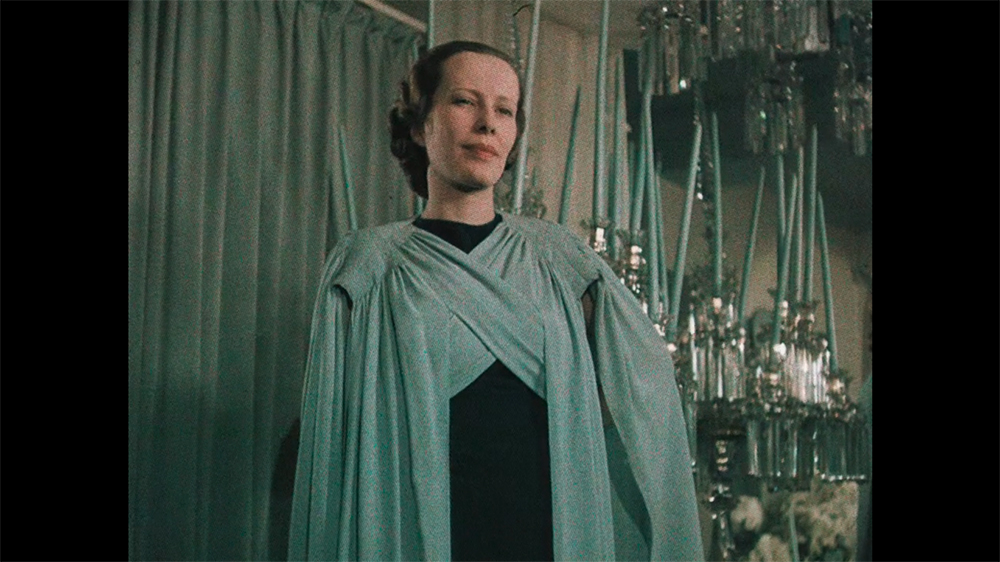
Jennings continues to emphasise the connection between objects and labour in his late poem ‘As I Look’ (1949), which watches over a city roofscape:
I perceive in the grey picture all the colours that were once there,
Not only the simple divisions of the prism
Brilliant orange iron ore peacock coloured coal
I perceive also the hues of the men who built the city (300)
Highlighting the accretion of individual efforts that construct a city, Jennings writes: ‘Each slate in its place, every one put there by a man’ (“As I Look” 300). Both ‘As I Look’ and Making Fashion acknowledge the collective labour underpinning society. In the former, the hues of different workmen colour the otherwise dull roofscape, while in Making Fashion the workroom staff embellish an evening dress with hundreds of individual sequins. Throughout his career, Jennings would comment on the interdependence between labour and objects, helping to strip the latter of their capacity to spellbind society. In 1943 he wrote about his birthplace, the seaside village of Walberswick: ‘But the church towers from the past, the jetties and piers, the mills and lighthouses … we must never forget that they were made and built and created and tended by the people – not by those powers for whom they were put up or whose names they bear or whose money allowed them to call them theirs’ (“Walberswick” 7). In the context of Making Fashion, Hartnell’s name appears on the labels of his clothing despite his deep indebtedness to his mainly anonymous workroom staff. Jane Hattrick describes how Hartnell was often presented as the artistic genius regardless of the fact that his two-dimensional designs required a significant amount of ‘staff input at all levels and that the contribution of these (mostly) women was key to the realisation of each model’ (224). Although Hartnell’s staff were an essential part of his fashion house, they generally inhabited cold and uncomfortable conditions. Referencing the 1965 inventory for Hartnell’s second floor workroom, Hattrick explains how little had changed since the 1930s:
Fourteen fluorescent strip lights, chokes and starters, canopy suspended shades, thirty-eight stickback chairs, six deal worktables, three deal work tables, fitted drawers, two electric convector fire in gilt metal case, a singers electric treadle sewing machine, forty-five dummies, three ironing boards, three sleeve boards, three electric irons, fifteen flat irons, gas iron, heating plate, three burner gas heater for irons, nine hat blocks and twenty-four chrome and wood hat stands (227).
Making Fashion emphasises the difference between the utilitarian workroom and the opulent studio: a shot of the tea gown being made in a dark room, lit by a basic electrical lamp, is juxtaposed with a shot of the studio, where a young lady models the dress beside a lavish chandelier (see Figure 3 and Figure 2). This juxtaposition once again reminds the viewer that Hartnell’s fantastic dresses are founded upon the dull reality of worktables, electric irons and gas heaters.
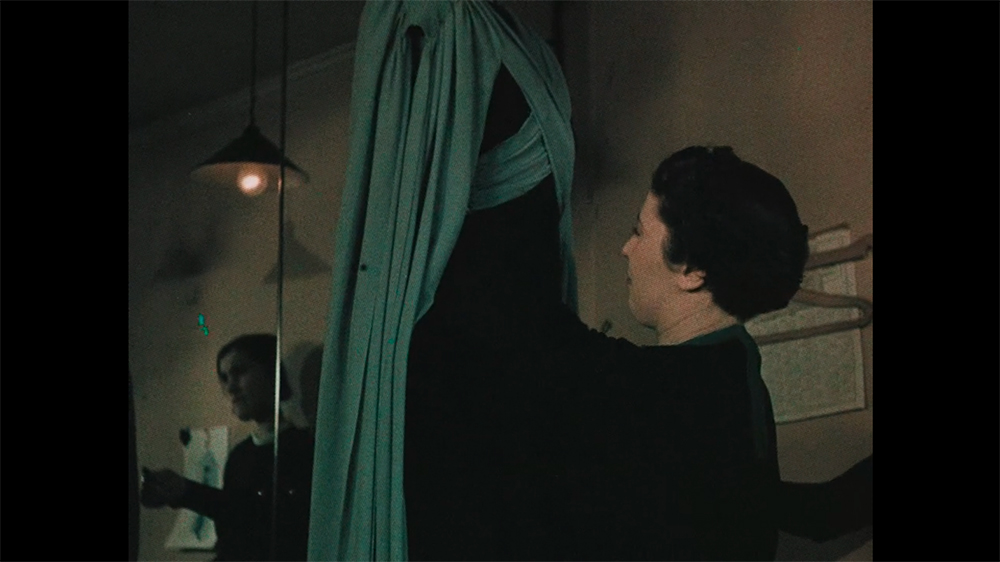
In addition to differences in colour and furnishings, Jennings distinguishes between the fashion house and workrooms through the contrast of high and low camera angles. He shoots the tea gown model from a low angle, looking upwards (see Figure. 2). In contrast, the seamstresses are shot from a high angle that looks down upon them working and gives the impression that they labour under scrutiny (see Figure 4 and Figure 5). While the tea gown model appears statuesquely powerful, the seamstresses look comparably subordinate and once again the differing social situations of these women are communicated. Philip Logan comments on Jennings’ film: ‘The studio is the world of the designer, his personal assistants and models, where the refined accomplishment of Hartnell’s creativity can be fully appreciated. Meanwhile in the workrooms, the assembly of gowns carries on apace. Geographically close, but socially separate, the studio and the workrooms have their own distinct social and cultural milieu’ (73). The women in the workrooms glamorise their otherwise drab environment by sticking photographs of celebrities on the walls. A woman sews together the tea gown and the narrator states: “From the workroom walls the stars look down” (00:03:22-00:03:25). The film cuts from the worker to a photograph of Bing Crosby. Where the seamstresses find their stars in the celebrities of crumpled magazines, the models find them in the sequins and diamonds on their clothes. These two fantasies are equally absurd, only the former is considered less respectable and is therefore more easily noticed. The ideals promised by Persephone reveal themselves as fantasy through the shared significance of diamonds and magazine cuttings. The endurance of fantasy in supposedly rational twentieth-century society fascinated Jennings to the degree that the modern ‘conflict of animism and materialism’ is precisely what Pandaemonium attempted to illuminate (Jennings “Introduction” xiv). Within the scientific mindset of the modern world, there is seemingly little space for the animistic imagination, which infused inanimate objects with spirit and power. Describing how the machine-age has seemingly shut out these spirits, Pandaemonium includes John Ruskin’s description of the valley between Buxton and Blakewell, which was ‘once upon a time, divine as the vale of Tempe; you might have seen the Gods there … - Apollo and all the sweet Muses of the light’, but since the building of the railroad ‘the valley is gone and the Gods with it’ (325). For Jennings, however, modernity did not completely destroy society’s imaginative outlook, but merely displaced it. Kevin Robins and Frank Webster explain that the gods have not left the modern era, they have merely made their homes elsewhere (32). Pandaemonium presents how humankind can still connect to the world of the gods through the latest technological advances, such Victorian balloon rides: ‘sailing along almost amongst the stars, free as ‘the lark at heaven’s gate’, and enjoying, for a brief half hour, at least, a foretaste of the Elysian destiny, which is the ultimate hope of all’ (Mayhew and Binny 267). Jennings’ work examined magical modes of thinking in modern society to illustrate how imaginative thought is inextricably linked to the productive powers of capitalism and, conversely, how the assumed rationality of capitalism is in fact swathed in fantasy. The interdependence between labour and imagination is a prime concern for Jennings. As he states in his introduction to Pandaemonium: ‘The relationship of production to vision and vision to production has been mankind’s greatest problem’ (xviii). For Jennings, humankind cannot live for its productivity alone and its imaginative capacity, however seemingly subjugated by a mechanistic and utilitarian environment, will continue to exist. In Making Fashion, Jennings presents this persisting imagination in the daydreams of the seamstresses, thereby addressing the social concerns that he was dealing with more overtly in other contemporaneous projects such as Pandaemonium. Unable to explicitly express his complex understanding of vision and production in a commercial film like Making Fashion, Jennings instead presents it in silent commentary through the markedly different but undoubtedly intertwined fantasies of the models and seamstresses.
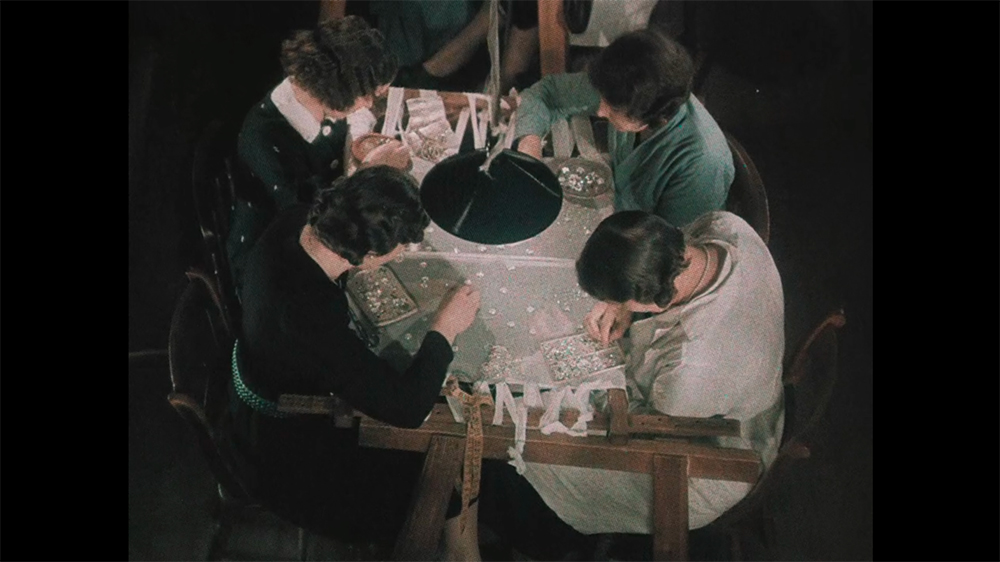
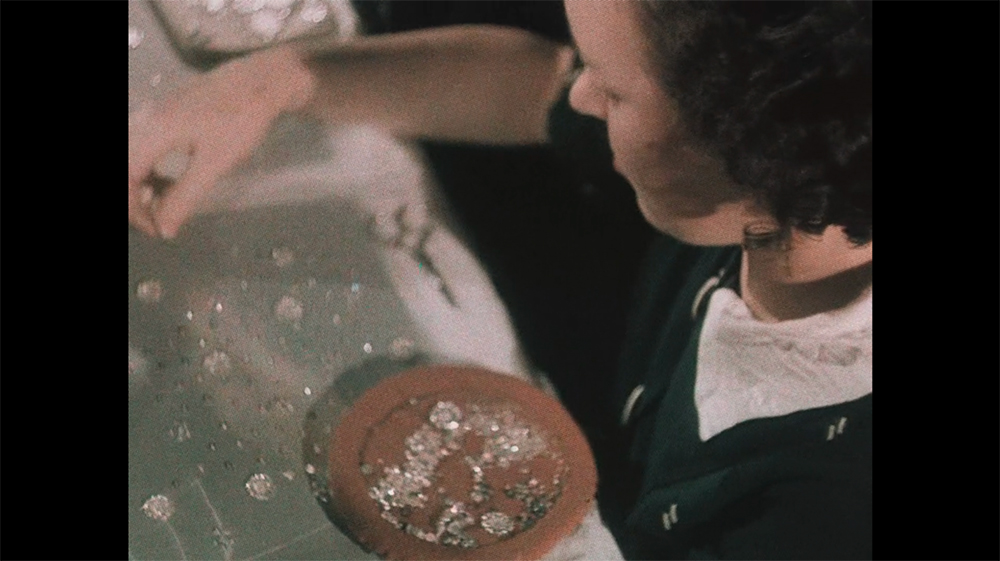
To better understand Jennings’ method of tacit critique, particularly how such critique penetrates seemingly optimistic films with an underlying serious social message, it is important to consider A Diary for Timothy. The documentary film traces the first six months in the life of a baby called Timothy, who was born in 1944 towards the end of the Second World War. The film’s narrator looks to peacetime and asks the newborn: “What are you going to say over it [the future] and what are you going to do?” (00:36:19-00:36:22). Alessandra Marzola argues that behind the film’s apparent optimism for the emerging welfare state there is a picture of a hopeless society living in the aftermath of two world wars: ‘In spite of its laboured emphasis on rebirth and new democracy, and indeed contrary to its declared purposes, Jennings’s film dooms Timothy and war babies to the impotence of doubt, ushering them into a future ridden with uncertain prospects’ (134). The film depicts society’s mindless consumption of positive signals of peace and enjoyment. Families gather around the wireless listening to news reports on the final stages of war and people are gripped by Myra Hess’s National Gallery performance of Beethoven's Piano Sonata No. 23 in F minor. While the audiences in Jennings’ film passively ingest heartening discourses of war bulletins and musical entertainment, his own audience similarly endures the positivism of A Diary for Timothy through E. M. Forster’s text, which narrates the film and is authoritatively delivered by Michael Redgrave. However, audience inertia is disrupted by the documentary’s inclusion of an excerpt from the 1944 Haymarket Theatre’s production of Hamlet. Although the play was a means of boosting patriotism in wartime Britain, Jennings’ editing highlights Hamlet’s morbidity and thereby furnishes the documentary with a sense of the funereal, cutting Timothy’s prospective future short with the notion that death may strike at any moment. Jennings introduces the play with the Gravedigger, who announces the madness of the English people. As the audience laughs the film cuts to a contemporary canteen where an Air Raid Precautions Warden discusses the intricacies of a military operation. Hamlet’s comedy transforms this piece of war planning into a farce. The film then cuts to the Gravedigger’s description of the court jester Yorick, reinforcing the farcical tone. Hamlet takes Yorick’s skull in his hands and laments his death, exclaiming: “Alas, poor Yorick!” (00:18:42). The film cuts back to the canteen as a bomb unexpectedly explodes outside, causing the warden to spill his tea. Here, a parallel between Yorick and the warden is established, making the latter appear foolish in his attempt to calculate against death with his complicated manoeuvres. As Marzola states: ‘Feeding upon each other, screen and play are made to elicit a symptomatic vision, as if the film were now to be reeled back in the light of its central sequence, and as if Shakespeare’s graveyard scene were to be reconsidered, along with the whole play, in light of this film documenting the end of war’ (138). Without making an explicit statement, Jennings purposefully edits Hamlet into the heart of A Diary for Timothy to speak of mortality and madness in the Second World War. Similarly, Jennings weaves literary readings of Persephone into Making Fashion’s narrative and the Greek goddess becomes a catalyst for the film’s critical subtext regarding the social inequalities within Hartnell’s fashion house.
3. Making Fashion’s Literary Allusions
To support the claim that there are critical undertones resonating throughout Making Fashion, causing the film to harmonise with the serious social commentary found in much of Jennings’ other work, it is important to establish where he harnessed the skill of indirect communication. Jennings’ reluctance to make direct statements can be related back to his interest in poetry when he was a student at Cambridge. In 1929 Jennings received a first-class honours degree in English and started a doctoral thesis on Thomas Gray under I. A. Richards at Pembroke College. While Jennings was at Cambridge, Richards delivered a course of lectures on ‘Practical Criticism’, which promoted the interpretation of poetry purely through words rather than through preconceived ideas or established beliefs surrounding the work. According to Richards, recourse to prevailing interpretations blocks the reader’s psychological response to a poem and, in turn, their understanding of the poet’s psychological experience when writing:
But ordinarily we at once try to consider the objects his words seem to stand for and not the mental goings-on that led him to use the words. We say that we ‘follow his thought’ and mean, not that we have traced what happened in his mind, but merely that we have gone through a train of thinking that seems to end where he ended. We are in fact so anxious to discover whether we agree or not with what is being said that we overlook the mind that says it (Practical Criticism 7).
‘Practical Criticism avoids reaching final conclusions when reading poetry and suggests that the reader ‘look not for one meaning but a number of related meanings’ (Practical Criticism 344). In 1933 Richards wrote a reference for Jennings stating that ‘his powers of assimilation, of perceiving possible and hitherto unnoticed connections and of synthesis and synthesising his perceptions with systems, are most impressive’ (Uncatalogued Humphrey Jennings Collection). In ‘Plagiarism in Poetry’ (1937), broadcast by the BBC at the time Making Fashion was being made, Jennings drew upon Richards’ teaching when discussing the manifold influences that often help to construct a poem. Jennings claimed that Gray’s ‘Elegy written in a Country Churchyard’ (1750) borrowed from the poetry of Milton, Dante, John Dryden and Alexander Pope: ‘I suggest not that he [Gray] had all the books open in front of him, or that he worked it out in a laborious way, but that he certainly had all these things at the back of his mind’ (“Plagiarism” 248). Jennings, like Richards, saw poetry as a web of psychological intentions from which the single thread of an idea could not be untangled. This web is central to Jennings’ work and the instrument through which he believed the psychology of the artist and receiver could be caught. Blocking the enunciation of bold statements, this nexus of literary intentions is precisely the framework in which the subversiveness of Making Fashion can be understood. In an article for Literature/Film Quarterly Thomas Zaniello comments on Jennings’ documentary filmmaking and its ability to synthesise information: ‘Jennings used the medium of film imagistically and allusively (relying on recurrent images, the association of images and ideas, and literary allusions), in a manner analogous to music and poetry’ (27). The poet Kathleen Raine, a close friend of Jennings and fellow Cambridge student, adds to the theory that Jennings’ work was referential by claiming that he ‘preferred phrases that were taken from already existing sources, for this, he felt, reduced the personal element in poetry to a minimum’ (Collected Poems 4). Just as Gray alluded to Milton, Dante, Dryden and Pope, I argue that Making Fashion was influenced by Raine’s, T. S Eliot’s and D. H. Lawrence’s poetical presentations of Persephone. Furthermore, these literary associations help Jennings to develop his subtle social critique of the labour underpinning the fashion world.
Persephone was clearly an important figure for Raine, who identifies with the Greek goddess in her autobiography and in her poetry (Land Unknown 52; “The Transit of the Gods” 83). This paper argues that her 1941 poem ‘Thought by the Thames in Summer 1938’ conjures Persephone in an echo of Making Fashion’s filmic interpretation of the goddess. It is unsurprising that Raine and Jennings present similar impressions of Persephone given their close friendship, which included feedback on, and support of, one another’s intellectual pursuits.6 This friendship intensified in 1938, the year Making Fashion was released, when Raine and her partner, Charles Madge, moved to Blackheath in London partly to be closer to Jennings. With this in mind, and considering the title of ‘Thought by the Thames in Summer 1938’, one wonders whether Raine’s poem was the result of discussions with Jennings at Blackheath around the time he was working on Making Fashion. I identify the protagonist of ‘Thought by the Thames in Summer 1938’ as the Greek goddess, who is despairing at her descent into the underworld:
Between seeing and being
I fear to pass the surface of the river
The smooth field of the water, the appearance of the mirror
(oh beautiful to see the stream and spirits walking on the moving water.)
I fear to drown, drawn down
into your arms, your element, your living
under that face, under that …
and closing over me the flow
whole pale bright water turns to blood.
Between our seeing and our being together
Appears the impossible seeming of a world –
A mirror, a bathing angel, …
End and beginning, birth and death become each other
In sea, that drowns what it creates, my love, my terror (Raine Thought by the Thames in Summer 1938).
Raine’s poem discusses the celestial world and the underworld. The river’s fluidity has the potential to mix the two domains and this strikes fear into Raine’s protagonist. The last line of the poem suggests that if the two worlds merge then the vision of ‘beautiful … spirits walking on the moving water’ will be destroyed (Raine Thought by the Thames in Summer 1938). Persephone is currently protected from the integration of the two worlds because the still river provides a barrier in its mirror-like appearance, which reflects the goddess back on herself. Raine’s Persephone, as one of Hartnell’s models, exists in the celestial world of the gods and, dazzled by mirrors and diamonds, is unable to observe the labour that underlies her existence. Raine’s poem wills Persephone’s descent into the underworld, which for Jennings would be the models’ drop into one of Hartnell’s workrooms. Making Fashion suggests this fall in a sequence that begins with the camera looking down onto a smoking chimney (see Figure 6). The film cuts to the base of an evening dress and slowly tilts upwards to show the entire garment (see Figure 7). Jennings then presents a Greek terracotta figure, which is thought to be Persephone (ca.330BC), from a low angle (see Figure 8). The low-angle shots continue in the image of an aquamarine dress and persist in the photograph of the actor Robert Taylor, which has been stuck to the workroom wall. This upward perspective is broken with a close up of a seamstress pinning an evening gown in a downward motion (see Figure 9). Jennings’ audience looks up at the lofty existence of fashion models and film stars. However, their elevated position is hemmed in by the two downcast shots representing industry: the smoking chimney and the pinning of the dress. From this perspective, the ‘heavenly’ world of the rich and famous is tethered to an industrial underbelly and is brought back down to earth.
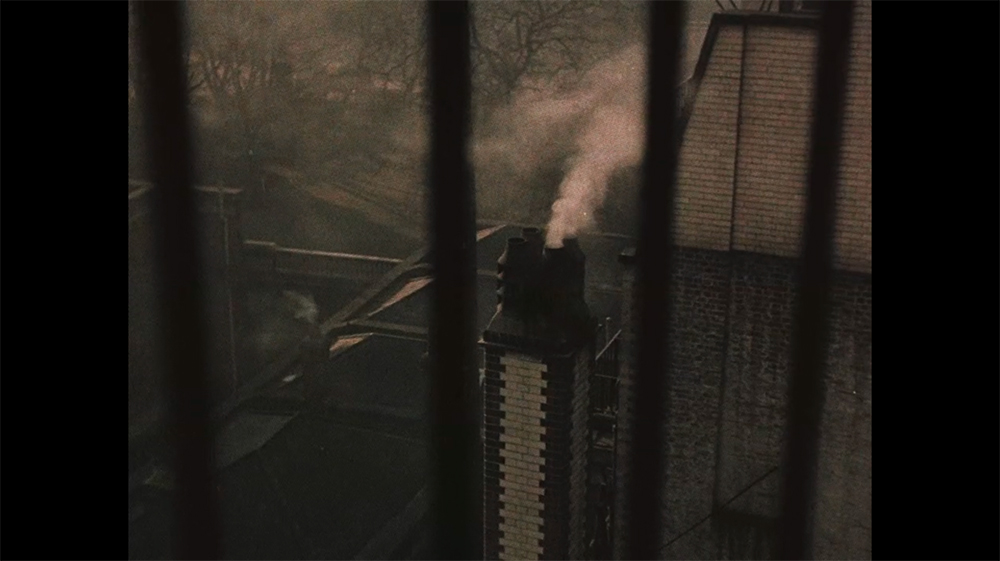
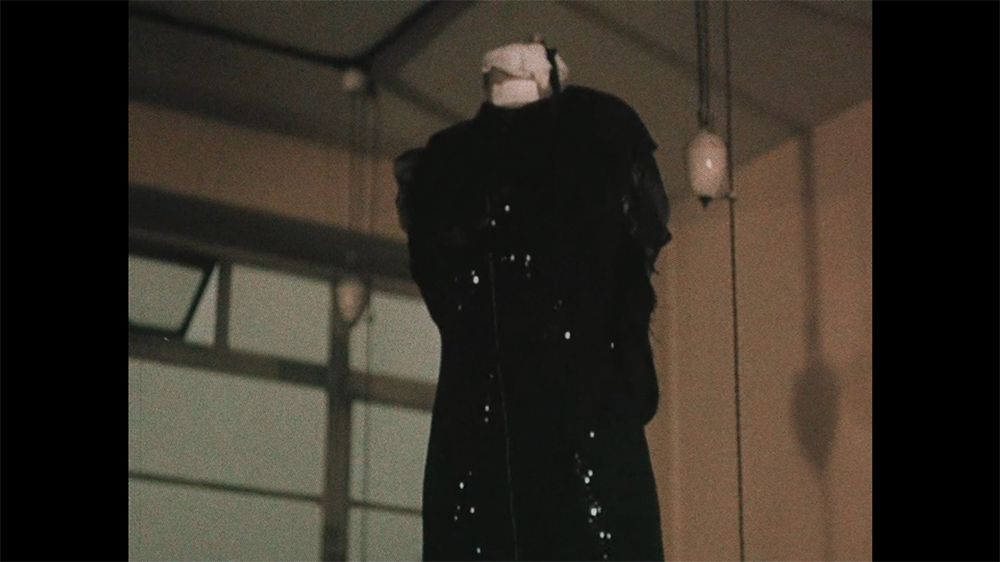
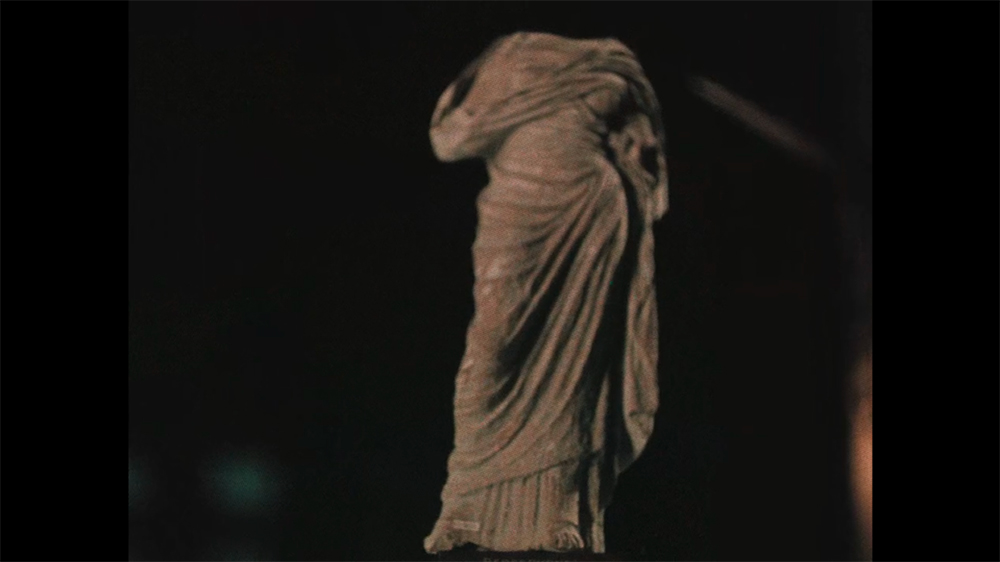
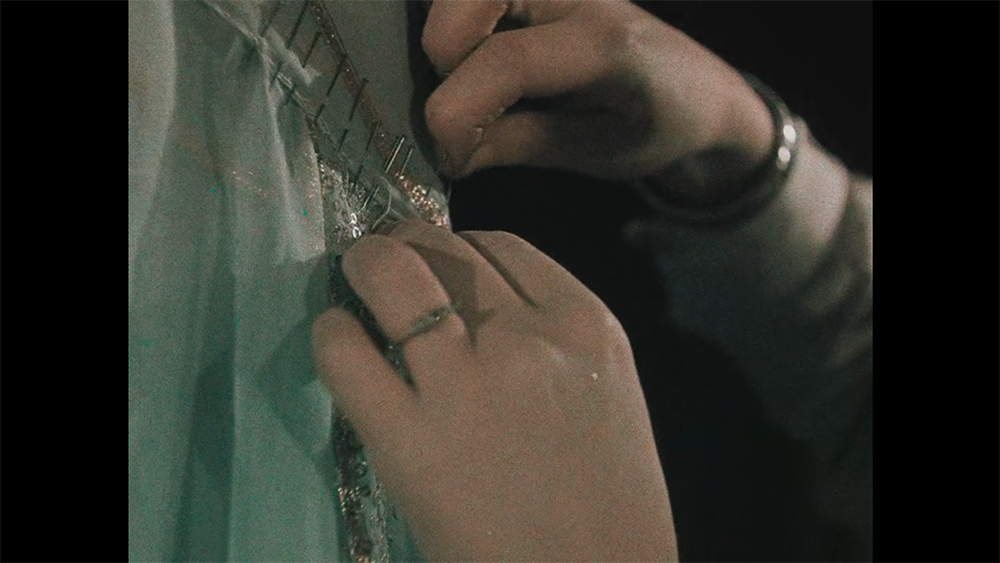
Jennings exposes the fantasies of Hartnell’s fashion house from the very start of Making Fashion, introducing the audience to the “cold sunlight of a London winter” (00:00:42-00:00:47) and stating: “While the bare branches wait for spring, artificial flowers for spring dresses are being made with scissors and paste” (00:06:09-00:06:15). Johann Strauss’ Voices of Spring (1882) accompanies a shot of a leafless tree outside the British Museum, juxtaposed with a shot of a woman sewing artificial flowers onto an evening gown. At the point where the flowers are being sewn, Strauss’ flute imitates birdsong. Image and music complement one another in their cultural depictions of nature, working together to highlight the sophistication of their art. However, this sophistication distances both artforms from the nature they attempt to depict, resulting in a sense of artifice that is reinforced by the voiceover: “flowers from hothouses and the warm south come to decorate the showroom” (00:06:38-00:06:39). The narration alludes to Milton’s Paradise Lost (1667): ‘In Eden on the humid flowers, that breath’d their morning incense’, which Jennings associates with this line in Gray’s ‘Elegy written in a Country Churchyard’: ‘The breezy call of incense breathing morn’ (Milton 12; Gray quoted. in Jennings “Plagiarism” 247). The redolent imagery of Jennings, Milton and Gray recalls the ‘synthetic perfumes’ of Eliot’s degraded hyacinth girl, who dresses herself in jewels and awaits the judgement of her neglectful lover in ‘The Game of Chess’ section of The Waste Land (1922) (Eliot “Waste Land”33). Eliot recalls the drowned Persephone as he describes the overwhelming surroundings of the woman’s bedroom by using words like ‘unstoppered’, ‘drowned’ and ‘stirred’ (“Waste Land”33). This atmosphere is intensified by a painting that hangs over the fireplace suggesting the rape of Philomel, a Greek myth that has obvious associations with Persephone’s story. The painting, ‘hushing the room enclosed’, causes the woman to adopt the muteness of Philomel, whose tongue was cut out by her attacker Tereus (Eliot “Waste Land”34). Eliot uses the room’s décor to furnish his poem with a sense of Greek tragedy. Similarly, one could argue that Jennings draws upon the décor in Hartnell’s studio, in the form of the Persephone statue, to subtly express the goddess’ downfall into Hades. From this perspective, the negative aspect of Persephone’s myth conjures a morbid atmosphere completely at odds with what, at first glance, seems to be the celebratory subject matter of Making Fashion. The Wedgwood decoration in Hartnell’s studio provides a similarly macabre clue when read through Raine’s A. W. Mellon lectures (1962), where she considers Persephone as Lyca in Blake’s poems ‘A Little Girl Lost’ and ‘Found’ (1794). Raine begins with a discussion of Wedgwood pottery, just as Making Fashion begins with the blue and white Wedgwood in Hartnell’s studio. Raine explains that Blake’s good friend John Flaxman prompted Wedgwood to make a replica of the Barberini vase, a cult object of the Eleusinian Mysteries, which focused on the ascent of Persephone from the underworld and her reunion with her mother, Demeter. A year after the replica was made, Erasmus Darwin published The Botanic Garden (1791), which included an engraving of the vase by Blake. Raine describes how ‘Little Girl Lost’ and ‘Found’ were based upon the Mysteries and more specifically the Wedgwood vase. Despite the Mysteries being a celebration of Persephone’s escape from Hades, Raine emphasises the dark aspects of the myth, noting that the vase was a funeral vessel, ‘designed to hold the ashes of the dead’ (Blake and Antiquity 34). Raine explains how the ‘maiden [Persephone] holds in her hand an inverted torch, emblem of death; she and the attendant figures who gravely watch her sit under a tree’ (Blake and Antiquity 35). Discussing ‘A Little Girl Lost’ and ‘Found’, Raine continues her morbid interpretation: ‘So Lyca [Blake’s Persephone figure] leaves the country of everlasting summer for the caves of the underworld and remains, throughout the poems that follow, asleep’ (Blake and Antiquity 40). Raine has already explained that for Blake sleep is an equivalent of death (Blake and Antiquity 34). This gloom-ridden Persephone can be linked back to Making Fashion through Raine’s autobiography, which presents a strong connection between Jennings and Blake:
I see him [Humphrey], in memory, as an incarnation of Blake’s Los, spirit of prophecy; whom in appearance, with his full flashing eyes and mane of yellow hair, he much resembled. Humphrey used to declaim, with ‘the mouth of a true orator’, long passages of Blake’s prophetic books (The Land Unknown 48).
This connection suggests that although Jennings had been dead for twelve years prior to the Mellon lectures, Raine’s ideas on Persephone in ‘A Little Girl Lost’ and ‘Found’ may have been generated with her Cambridge peer. If Raine and Jennings had worked together to construct this pessimistic reading of Persephone, as described in Raine’s lectures, then the negative undertones of Making Fashion become even more plausible.
To deepen our understanding of Jennings’ dismal depiction of Persephone, we turn to Lawrence’s first novel, The White Peacock (1911). In 1929 Jennings admits to having not read Lawrence, but promises to rectify his neglect: ‘I haven’t read the D. H. Lawrence I’m afraid … I have never read anything of his – isn’t that awful? Especially as I am sure from what people have said he is our kind of writer – but I will’ (1926 to 1929: Cambridge and Courtship 88). By 1938, the year Making Fashion was released, Jennings had clearly fulfilled his promise as his BBC broadcast The Disappearance of Ghosts discusses The White Peacock (1911). Lawrence’s novel indicates the importance of light and dark with regards to the upper and underworld that Persephone represents. I argue that Jennings expresses similar significance in Making Fashion, exploiting the capabilities of Dufaycolor in the process. Jennings’ film starts with the “cold sunlight of a London winter” (00:00:42-00:00:47). The camera tilts downwards from a leafless tree against a light blue sky to the dark iron railings outside the British Museum (see Figure 10 and Figure 11). In one shot Jennings moves from aerial freedom to caged confinement, and so the descent into the underworld begins. The light blue sky contrasts the following shot, which shows the ‘Persephone’ statue in the dark interior of the Museum. This gloom complements the statue, which presents the goddess seated on her throne in the underworld. The start of Making Fashion sinks into increasing darkness and is reminiscent of this line from Lawrence’s late poem ‘Bavarian Gentians’ (1929), which describes the coming of winter and Persephone’s descent into the underworld: ‘down the darker and darker stairs, where blue is darkened on blueness’ (584). The tone of Making Fashion is somewhat lifted as the camera cuts from the British Museum to the blue and white walls of Hartnell’s studio, where a woman models the tea gown (see Figure 2). Her tall, slim appearance is remarkably similar to Lettie, one of Lawrence’s Persephone figures in The White Peacock:
Lettie stood between the firelight and the dusky lamp-glow, tall and warm between the lights. As she turned laughing to the two men, she let her cloak slide over her white shoulder and fall with silk splendour of a peacock's gorgeous blue over the arm of the large settee (Lawrence 257).
Throughout the novel Lettie is associated with light, which Virginia Hyde understands as a symbol of civilised consciousness. Lawrence often connects ‘the mental-spiritual woman with “enlightened” society: she may be “pale” because drained of sensual substance (which he often relates to brilliant colours) by civilisation’ (Hyde 102). Hyde suggests that these modern women may find some salvation in Pluto, who rescues Persephone from the glaring light and plunges her ‘into his own realm of healing darkness’ (103). Lawrence’s description of the lamp-glow as ‘dusky’ injects Lettie with an element of Plutonic gloom (The White Peacock 257). Similarly, Jennings presents Hartnell’s model beside an unlit chandelier (see Figure 2). While the chandelier signifies light, its lack of illumination subtly suggests darkness. Later in the film the chandelier’s crystal droplets knock together and the chime calls the models to the catwalk. Previous to the call, a model sits in a dark dressing room powdering her nose. The narrator states: “The mannequins prepare for long days of showing and changing” (00:06:40-00:06:45). One after another the models exhibit their dresses, as if they are on a production line. The chandelier’s call to the catwalk links the light and glamour of the studio with the industry of the workrooms. The studio’s underlying gloom is further suggested in its stark contrast to the brightness of the film’s final scene, which takes place outside Hartnell’s fashion house and beyond the grimy city. Jennings finishes Making Fashion with the camera looking up at a blue sky dotted with white, fluffy clouds. The camera settles on one of Hartnell’s models, which the voiceover describes as a modern Persephone. In her wedding dress of white lace and diamonds, she stands on a balcony and releases a dove in the spring sunshine. Here, Jennings clearly references the goddess’ ascension from the underworld. The film finishes with a host of golden daffodils blowing in the breeze (see Figure 12). The flowers’ colour and motion signify spring and freedom. These daffodils contrast the reds and purples of the hothouse flowers that decorate a dark corner of Hartnell’s studio (see Figure 13). In comparison to the final scene of Making Fashion, the studio appears claustrophobic with its shadowy corners and low chandeliers. On reflection, space seems condensed in Hartnell’s fashion house, causing the upper world of the studio and the lower world of the workroom to close in on one another. As these two domains combine, one wonders whether the entirety of Hartnell’s fashion house, and therefore the main body of Jennings’ film, resides within the underworld. If this is the case, then Making Fashion’s opening and closing sequences, its descent into darkness and ascension into light respectively, make perfect sense. Just as Lawrence demonstrates how Lettie’s civilised state does not protect her from Plutonic darkness, Jennings illustrates how the models’ social status does not leave them entirely unsullied from the bleak reality of industry.
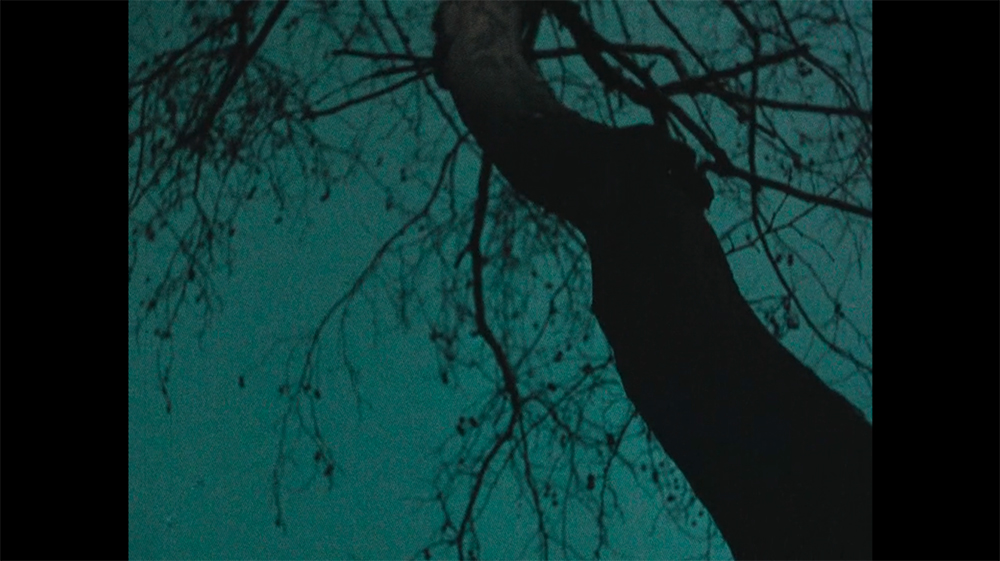
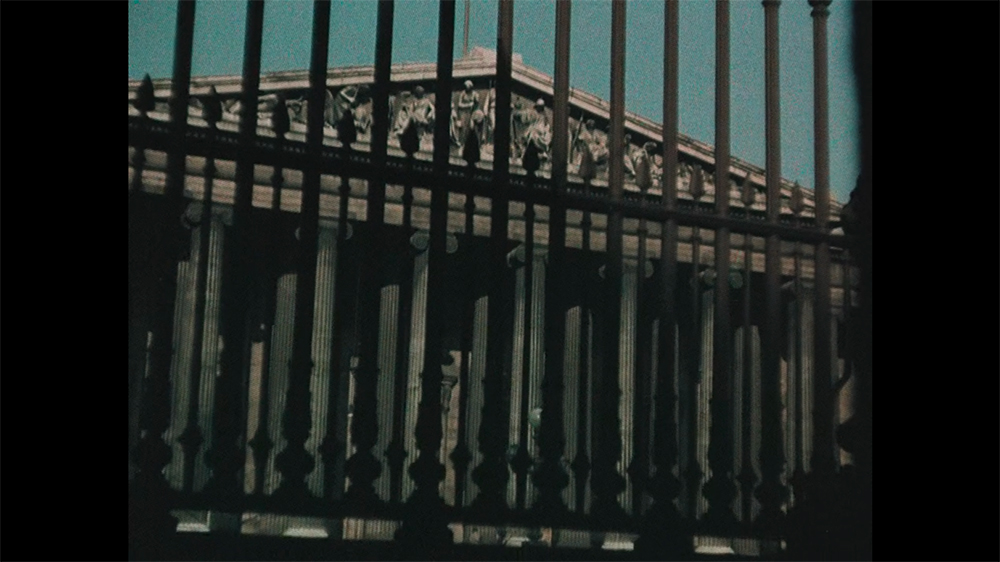
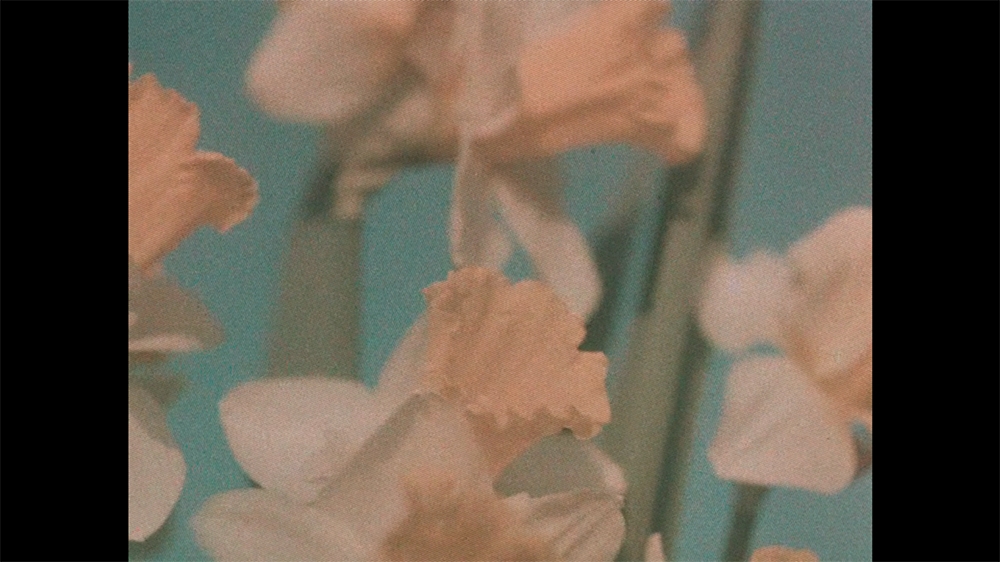
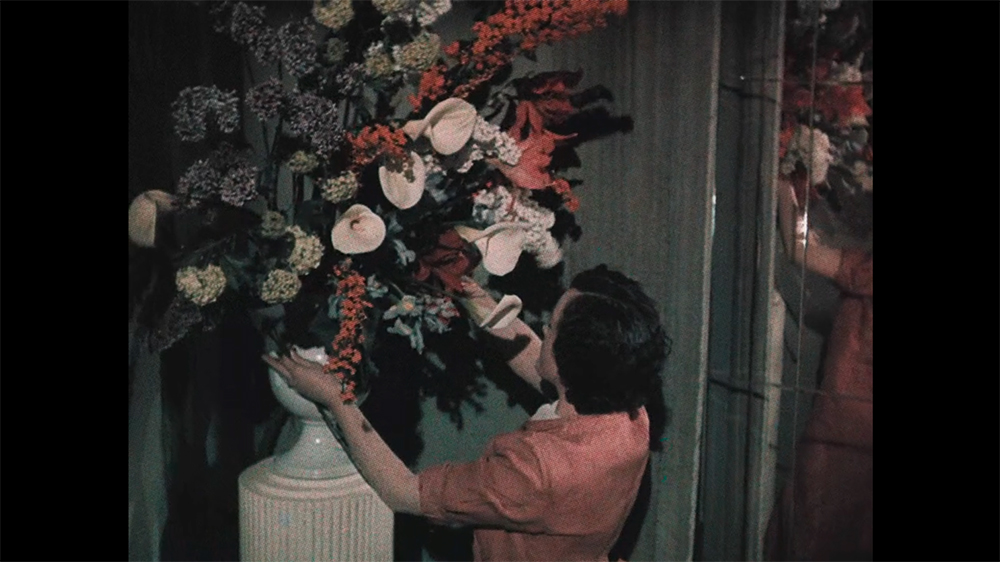
When watching Making Fashion for the first time, one may view the film as light-hearted advertising and remain oblivious to Jennings’ concern for the seamstresses’ exploitation inHartnell’s fashion house. However, when one considers Jennings’ preoccupation with the conditions of the working class in late 1930s Britain, in conjunction with his tendency to inject seemingly optimistic films with serious social critique, Making Fashion starts to adopt weighty undertones. Persephone acts as a metaphor for the film’s critical subtext, with the goddesses’ entrapment in the underworld as illustrative of the seamstresses’ social confinement to the industrious labour within Hartnell’s workrooms. Jennings expresses this metaphor through the film’s commentary, camera angles and use of colour, alongside allusions to twentieth-century literary representations of Persephone’s abysmal state. After careful analysis, Making Fashion’s jocundity dissipates and one concludes that despite the fantastic beauty of Hartnell’s dresses, the film never forgets the quotidian labour by which they are made.
Endnotes
1 Making Fashion is also referred to as Design for Spring.
2 As his wife Cicely so succinctly put it in 1938: ‘Money really is the important factor – we shall have to be poor and careful for a long time to come’.
3 Basil Wright dismisses Jennings’ early films, which includes Making Fashion: ‘None of the films of his first period, except perhaps Spring Offensive … showed the total grasp of the film medium seen in his subsequent work’ (7). Wright’s opinion is reiterated by Jennings’ Cambridge contemporary Gerald Noxon, who speaks of Spare Time (1939) as Jennings’ ‘first significant work as an artist in film’ (26).
4 Jennings states that a modern poet, like Edith Sitwell, may write about her privileged childhood but this bears no resemblance to the everyday life of a railway man from the Midlands (“The Poet and the Public” 256).
5 For the yellow smoke that slides along the street
Rubbing its back upon the window panes (Eliot “Prufrock” 2).
6 Raine wrote to Charles Madge on the 22nd April 1938: ‘Humphrey came round after lunch to see me and show me his script. Pretext was to see if what he said about Darwin was O.K., really because he just wanted me to see it. I was touched. Where have you put the zoo scripts? … He is talking about Tyger Tyger on the air and would like to see. His script is full of your ideas about popular poetry’ (Letter to Charles Madge). This letter is evidence that Raine and Madge helped Jennings develop his ideas in 1938 and support the suggestion that Raine may have influenced Making Fashion’s presentation of Persephone.
Works Cited
Arnold, Charles. “Persephone Statues.” Received by Sarah Watson, 09 Feb. 2015.
Barrow, Rosemary. Gender, Identity and the Body in Greek and Roman Sculpture. Cambridge, Cambridge University Press, 2018.
Blake, William. “And did those feet in ancient time.” The Poems of William Blake, edited by John Sampson, Chatto & Windus, 1921, p. 239.
---. “The Song of the Kings of Asia.” Pandaemonium, edited by Mary-Louise Jennings and Charles Madge, Icon Books Ltd, 2012, pp. 106-7.
Breward, Christopher. Fashioning London: Clothing and the Modern Metropolis. Oxford, Berg, 2004.
Bronowski, Jacob. William Blake and the Age of Revolution. London, Faber and Faber, 2008.
Brown, Simon. “Dufaycolor – The Spectacle of Reality and British National Cinema.” Centre for British Film and Television Studies, http://www.bftv.ac.uk/projects/dufaycolor.htm. Accessed 15 February 2020.
The Coronation of King George VI And Queen Elizabeth. British Pathé, 1937.
A Diary for Timothy. Directed by Humphrey Jennings, Crown Film Unit, 1946.
Eliot, T. S. “The Love Song of J. Alfred Prufrock.” The Waste Land, Prufrock and Other Poems, edited by Paul Negri, Dover Publications, 1998, pp. 1-5.
---. “The Wasteland.” The Waste Land, Prufrock and Other Poems, edited by Paul Negri, Dover Publications, 1998, pp. 31-43.
Engels, Friedrich. The Condition of the Working Class in England, edited and translated by W. O. Henderson and W. H. Chaloner, Basil Blackwell, 1958.
Frazer, James. The Golden Bough: A Study in Magic and Religion. New York, Macmillan, 1963.
Freud, Sigmund. “Totem and Taboo.” May the Twelfth: Mass Observation Day-Surveys, edited by Humphrey Jennings and Charles Madge, translated by Ernest Jones, Faber and Faber, 1937, pp. 265-6.
Gray, Thomas. “Elegy Written in a Country Churchyard.” Select Poems of Thomas Gray, edited by William J. Rolfe, Harper and Brothers Publishers, 1876, pp. 23-42.
Hattrick, Jane. A Life in the Archive: The Dress, Design and Identity of the London Couturier Norman Hartnell, 1921-1979. 2012. University of Brighton, PhD dissertation. https://search.proquest.com/docview/1777322914?accountid=14182.
Hodgkinson, Anthony, and Rodney Sheratsky. Humphrey Jennings: More Than a Maker of Films. London, University Press of New England, 1982.
Hyde, Virginia. ““Lost” Girls: D. H. Lawrence’s Versions of Persephone.” Images of Persephone: Feminist Readings in Western Literature, edited Elizabeth T. Hayes, University Press of Florida, 1994, pp. 99-120.
Jennings, Cicely. 1938. Uncatalogued Humphrey Jennings Collection, Pembroke College Library, Cambridge.
Jennings, Humphrey. “1926 to 1929: Cambridge and Courtship.” Humphrey Jennings, edited by Kevin Jackson, Pan Macmillan, 2004, pp. 46-98.
---. “As I Look.” The Humphrey Jennings Film Reader, edited by Kevin Jackson, Carcanet, 1993, p. 300.
---. “The Disappearance of Ghosts.” The Humphrey Jennings Film Reader, edited by Kevin Jackson, Carcanet, 1993, p. 254.
---. “Introduction.” Pandaemonium, edited by Mary-Louise Jennings and Charles Madge, Icon Books Ltd, 2012, pp. xiii-xix.
---. “Plagiarism in Poetry.” The Humphrey Jennings Film Reader, edited by Kevin Jackson, Carcanet, 1993, p. 248.
---. “The Poet and the Public.” The Humphrey Jennings Film Reader, edited by Kevin Jackson, Carcanet, 1993, pp. 255-83.
---. “The Song of the Kings of Asia.” Pandaemonium, edited by Mary-Louise Jennings and Charles Madge, Icon Books Ltd, 2012, pp. 106-7.
---. “To Walberswick.” Humphrey Jennings: Film-Maker, Painter, Poet, edited by Mary-Louise Jennings, British Film Institute, 1982, p. 7.
Jennings, Marie-Louise. Humphrey Jennings: Film-maker, Painter, Poet. London, British Film Institute, 1982.
Jones, Ann Rosalind, and Peter Stallybrass. “Renaissance Clothing and the Materials of Memory.” Fashion Theory: A Reader, edited by Malcolm Barnard, Routledge, 2007, pp. 58-75.
Lawrence, D. H. “Bavarian Gentians.” The Complete Poems of D. H. Lawrence, edited by David Ellis, Wordsworth Poetry Library, 2002, p. 584.
---. The White Peacock. London, Sovereign, 2013.
Logan, Philip. Humphrey Jennings and British Documentary Film: A Re-Assessment. Farnham, Ashgate, 2001.
“London on May 12.” May the Twelfth: Mass Observation Day-Surveys, edited by Humphrey Jennings and Charles Madge, Faber and Faber, 1937, pp. 87-166.
Lowinsky, Thomas. Modern Nymphs: Being a Series of Fourteen Fashion Plates. London, Etchells and Macdonald, 1930.
Madge, Charles. “Magic and Materialism.” Left Review, vol. 3, no. 1, 1937, pp. 32-5.
Making Fashion. Directed by Humphrey Jennings, Dufay-Chromex, 1938.
Marzola, Alessandra. “Negotiating the Memory of the ‘People’s War’: Hamlet and the Ghosts of Welfare in A Diary For Timothy by Humphrey Jennings (1944-45).” Shakespeare and Conflict: A European Perspective, edited by Carla Dente and Sara Soncini, Palgrave Macmillan, 2013, pp. 132-44.
Mayhew, Henry and John Binny. “A Balloon View of London.” Pandaemonium, edited by Mary-Louise Jennings and Charles Madge, Icon Books Ltd, 2012, pp. 264-7.
Miller, Tyrus. “Documentary/Modernism: Convergence and Complementarity in the 1930s.” Modernism/Modernity, vol. 9, no. 2, 2002, pp. 226-41, http://muse.jhu.edu/article/23489. Accessed 28 April 2019.
Milton, John. Paradise Lost. Oxford, Oxford University Press, 2004.
Mortimer, Raymond. “An Essay on Clothes.” Modern Nymphs: Being a Series of Fourteen Fashion Plates, edited by Thomas Lowinsky, Etchells and Macdonald, 1930, p. 16.
Noxon, Gerald. “How Humphrey Jennings Came to Film.” Film Quarterly, vol. 15, no. 2, 1961, pp. 19–26, www.jstor.org/stable/1210274. Accessed 28 April 2019.
Ovid. “The Fifth Book.” Metamorphoses, edited by Madeleine Forey, translated by Arthur Golding, The Johns Hopkins University Press, 2002, pp. 151-74.
Pitman, George. “Men in Our Time No.8 Humphrey Jennings.” Our Time, vol. 3, no. 12, 1944, pp. 12-3.
Raine, Kathleen. Blake and Antiquity. London, Routledge and Kegan Paul, 1979.
---. The Collected Poems of Kathleen Raine. London, Hamish Hamilton, 1956.
---. The Land Unknown. London, Hamish Hamilton, 1975.
---. Letter to Charles Madge. 1938, Correspondence, sketches and writings of Kathleen Raine 1935-1939, British Library, London, MS 80783.
---. Thought by the Thames in Summer 1938. 1941, Poetry notebook and journals, British Library, London, MS 88854-88856.
---. “The Transit of the Gods.” The Collected Poems of Kathleen Raine. London, Hamish Hamilton, 1956, p. 83.
Richards, A. I. Practical Criticism: A Study of Literary Judgment. London, Kegan Paul, 1930.
---. 1933. Uncatalogued Humphrey Jennings Collection, Pembroke College Library, Cambridge.
Robins, Kevin, and Frank Webster. Times of the Technoculture: From the Information Society to the Virtual Life. London, Taylor and Francis e-Library, 2005.
Ruskin, John. “The Gods.” Pandaemonium, edited by Mary-Louise Jennings and Charles Madge, Icon Books Ltd, 2012, p. 325.
Wright, Basil. “First Period 1934-1940.” Humphrey Jennings: A Tribute, edited by Kathleen Raine, British Film Institute, 1951, p. 7.
Zaniello, Thomas. “Humphrey Jennings’ Film “Family Portrait”: The Velocity of Imagistic Change.” Literature/Film Quarterly, vol. 7, no. 1, 1979, pp. 26-35, www.jstor.org/stable/43795704. Accessed 8 May 2019.